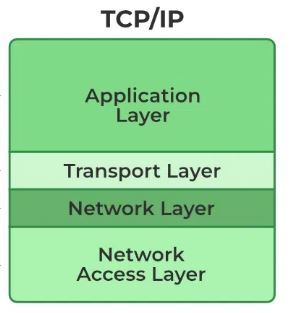With aid of a diagram, describe TCP/IP layer model
Answer:
1. Application Layer:
• Function: Provides network services and applications directly to users, like web browsing, email, file transfer, etc.
• Examples: HTTP, FTP, SMTP, DNS
• Position: Top layer, closest to the user
2. Transport Layer:
• Function: Manages reliable data delivery between applications on different devices, ensuring its integrity and sequencing.
• Examples: TCP (Transmission Control Protocol) for reliable, sequenced delivery; UDP (User Datagram Protocol) for faster, but unreliable, delivery
• Position: Above the Network Layer, below the Application Layer
3. Network Layer:
• Function: Responsible for routing data packets across networks, utilizing IP addresses for destination identification.
• Examples: IP (Internet Protocol) for addressing and routing, ICMP (Internet Control Message Protocol) for error reporting
• Position: Below the Transport Layer, above the Physical Layer
4. Physical Layer:
• Function: Deals with the physical transmission of data through the network medium, like cables or airwaves.
• Examples: Ethernet, Wi-Fi, Bluetooth
• Position: Bottom layer, closest to the network hardware

• Function: Provides network services and applications directly to users, like web browsing, email, file transfer, etc.
• Examples: HTTP, FTP, SMTP, DNS
• Position: Top layer, closest to the user
2. Transport Layer:
• Function: Manages reliable data delivery between applications on different devices, ensuring its integrity and sequencing.
• Examples: TCP (Transmission Control Protocol) for reliable, sequenced delivery; UDP (User Datagram Protocol) for faster, but unreliable, delivery
• Position: Above the Network Layer, below the Application Layer
3. Network Layer:
• Function: Responsible for routing data packets across networks, utilizing IP addresses for destination identification.
• Examples: IP (Internet Protocol) for addressing and routing, ICMP (Internet Control Message Protocol) for error reporting
• Position: Below the Transport Layer, above the Physical Layer
4. Physical Layer:
• Function: Deals with the physical transmission of data through the network medium, like cables or airwaves.
• Examples: Ethernet, Wi-Fi, Bluetooth
• Position: Bottom layer, closest to the network hardware
Share To Friends Via:



 Explain the types of transmission modes
Explain the types of transmission modes